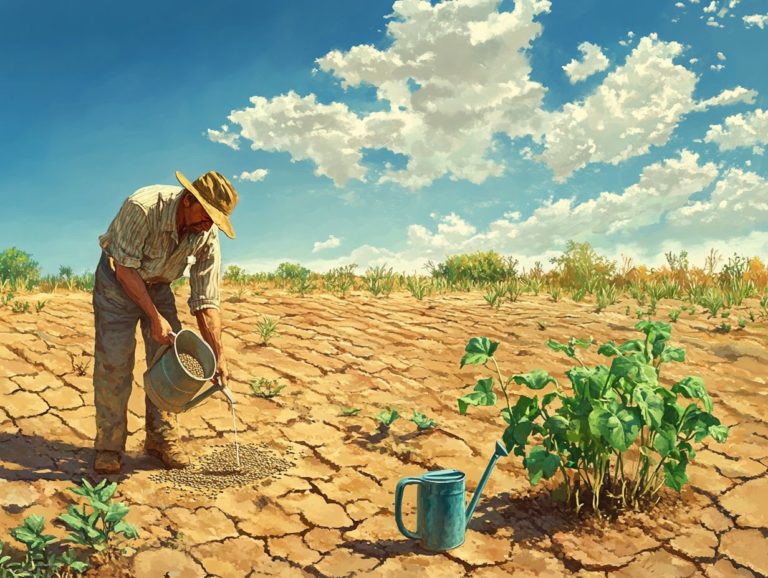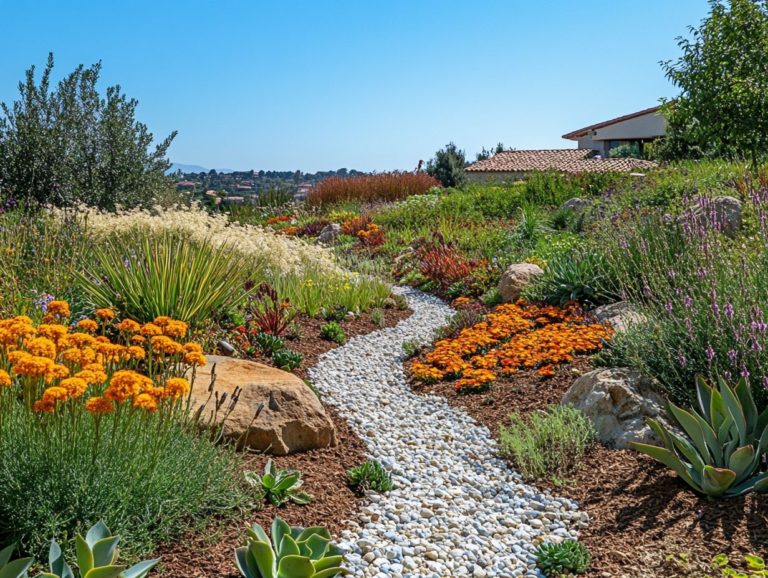Designing a Drought-Resistant Patio
Drought conditions are a growing challenge. They affect not only your gardens but also your outdoor living spaces.
A well-designed patio can elevate your home. It embraces water conservation and includes drought-tolerant plants for better aesthetics.
Get ready to discover how to transform your patio into a drought-resistant oasis! This guide provides insights into how drought impacts patios and how to select drought-resistant materials.
You’ll learn sustainable practices for irrigation and design, explore essential maintenance tips, and uncover the benefits of crafting a drought-resistant patio. Your patio will enhance your aesthetic appeal, contribute positively to the biodiversity of your landscape, and save you money.
Contents
- Key Takeaways:
- Understanding Drought and its Effects on Patios
- Designing a Drought-Resistant Patio
- Maintaining a Drought-Resistant Patio
- Additional Benefits of a Drought-Resistant Patio
- Frequently Asked Questions
- 1. What materials are best for designing a drought-resistant patio?
- 2. How can I incorporate plants into my drought-resistant patio design?
- 3. Are there any specific design techniques for creating a drought-resistant patio?
- 4. How can I reduce water usage on my drought-resistant patio?
- 5. What are the benefits of designing a drought-resistant patio?
- 6. Is it possible to have a beautiful and functional patio while also being drought-resistant?
Key Takeaways:

- Choose drought-resistant materials like gravel, permeable pavers, and succulents such as rosemary, thyme, and lavender. This minimizes water usage while keeping your patio green.
- Implement water-saving techniques like a drip irrigation system and rainwater harvesting. These methods lead to a more sustainable patio design.
- Regular maintenance keeps your patio beautiful and saves both water and money in the long run.
Understanding Drought and its Effects on Patios
Drought is an extended period of unusually low rainfall. It profoundly affects landscaping, especially in states like California, Arizona, Texas, Florida, Oregon, and Colorado.
The repercussions of drought go beyond mere water scarcity. They dictate which plants can thrive and influence how you design your patio to enhance sustainability and biodiversity.
As a homeowner, you may face challenges from harsh climatic conditions. You will need innovative solutions for optimal patio usage and maintenance.
Embracing drought-tolerant plants and water-efficient designs is not just a necessity. It’s a smart strategy for thriving in demanding environments.
What is Drought and How Does it Affect Patios?
Drought is an extended period of deficient rainfall compared to regional averages. It restricts the types of plants that can thrive in dry conditions.
In areas facing drought whether meteorological, agricultural, or hydrological water availability shapes outdoor spaces.
Prolonged meteorological drought depletes soil moisture, making it hard for traditional landscaping to flourish. This requires a thoughtful reimagining of your patio design, including how to design a drought-resistant landscape.
Many homeowners now embrace xeriscaping, a landscaping method that saves water while keeping your yard attractive. By selecting appropriate materials and native plants, you can create a patio that remains functional and beautiful, even during water scarcity challenges.
Designing a Drought-Resistant Patio
Designing a drought-resistant patio requires careful attention to detail. A strategic approach to materials, layout, and plant selection is essential.
Prioritizing water efficiency and sustainable practices will harmonize with the environment’s needs.
Through thoughtful planning, you can create a space that thrives in dry conditions. This patio will also contribute positively to the biodiversity of the surrounding ecosystem.
Start your journey to a sustainable patio today and enjoy the beauty while saving water!
Key Elements to Consider

When you’re designing a drought-resistant patio, focus on a few key elements:
- Selecting drought-tolerant plants
- Installing efficient irrigation systems
- Employing landscaping techniques that enhance soil moisture retention.
Incorporating porous hardscaping materials can promote better drainage while minimizing water runoff. Opt for lighter-colored stones or surfaces to keep the area cooler. This effectively reduces evaporation rates. By integrating organic mulch around your plants, you can suppress weeds while retaining moisture and improving soil structure over time.
Consider implementing a rainwater harvesting system to significantly boost your water conservation efforts. This allows for natural irrigation during dry spells. Aim to create a cohesive design that harmonizes these elements, resulting in a sustainable outdoor space that can thrive even in arid conditions.
Select the Best Materials for Your Drought-Resistant Patio!
Choosing drought-resistant materials is essential for crafting a sustainable patio design. To enhance your approach, consider learning how to design a drought-tolerant garden. This minimizes water usage while elevating the aesthetics and functionality of your outdoor space.
In this pursuit, using materials like organic mulch can enhance moisture retention. This ensures the soil remains hydrated for extended periods. Organic mulch also suppresses weeds and gradually enriches the soil as it breaks down. Consider pavers that let water through, which allow rainwater to seep and reduce runoff, promoting groundwater recharge.
Sustainable materials like reclaimed wood or eco-friendly composites create an inviting atmosphere while supporting your water conservation efforts. By selecting the right combination of materials, you can achieve a stunning and water-efficient outdoor oasis.
Water-Saving Techniques
Saving water is vital! Here s how you can do it as a homeowner maintaining a drought-resistant patio. Every drop counts in a landscape designed to flourish under challenging climate conditions.
Utilize methods such as drip irrigation, rainwater harvesting, and xeriscaping, which is a method of landscaping that reduces the need for watering. These can significantly reduce water usage while cultivating a robust, resilient garden. Drip irrigation delivers water directly to the roots, minimizing waste and maximizing efficiency. Collecting rainwater conserves resources and lessens your reliance on municipal water, making it a sustainable choice.
Xeriscaping involves selecting drought-tolerant plants that require less water and maintenance, creating an eco-friendly outdoor space. Together, these strategies not only support the health of your garden but contribute to broader water conservation efforts in areas affected by water scarcity.
Maintaining a Drought-Resistant Patio
Maintaining a drought-resistant patio is essential for its longevity and effectiveness. This endeavor requires commitment to sustainable practices that encourage healthy ecosystems and promote efficient water use, including understanding how to plan a drought-resistant garden layout.
By taking these steps, you contribute to the resilience of your patio and the well-being of the environment around you.
Tips for Long-Term Maintenance

For long-term maintenance of a drought-resistant patio, regularly monitor plant health, soil conditions, and irrigation efficiency. This ensures that all elements work in harmony to conserve water.
Keep a close eye on soil moisture levels to gauge when your patio plants truly need watering. This prevents over-saturation. Timing matters; watering in the early morning or late evening minimizes evaporation, allowing plants to absorb moisture more effectively.
Incorporating organic amendments like compost or mulch improves soil structure and enhances its ability to retain moisture. This fosters a sustainable environment.
By taking these thoughtful steps, you can cultivate a vibrant, low-water landscape that thrives even in challenging conditions.
Addressing Potential Issues
Addressing potential issues in a drought-resistant patio is essential for sustaining plant health and enhancing the overall performance of your landscape. To achieve this, consider how to plan a drought-resistant community garden, which is especially important for maintaining biodiversity and preventing common pests or diseases.
You may face challenges like identifying pests that thrive in drier conditions and managing plant diseases that arise from stress. It’s also crucial to ensure a well-balanced mix of flora that supports biodiversity and local wildlife.
For example, conducting regular inspections for pests like aphids or spider mites can help you catch infestations early. Introducing beneficial insects can naturally mitigate these issues.
To promote plant health, consider planting different types of plants together. Not only do these methods prevent disease, but they also enhance nutrient uptake.
By diversifying your plant selections with native species, you can create resilient ecosystems that support pollinators and improve soil quality. This approach aligns perfectly with sustainable practices.
Additional Benefits of a Drought-Resistant Patio
A drought-resistant patio provides a wealth of advantages that extend well beyond mere water conservation. It plays a vital role in enhancing the environment while also paving the way for considerable cost savings for homeowners over time.
Environmental and Cost Benefits
The environmental benefits of a drought-resistant patio are truly remarkable. You re not only promoting biodiversity but also improving soil structure and supporting sustainable practices that enrich your local ecosystem.
Beyond these ecological advantages, incorporating drought-resistant elements can lead to significant economic savings for you as a homeowner. By minimizing the need for excessive watering and maintenance, you ll enjoy lower utility bills while enhancing the aesthetic appeal of your outdoor spaces.
When designed thoughtfully, these patios harmonize beautifully with the surrounding landscape. They create a resilient environment that attracts beneficial wildlife and supports local biodiversity. This blend of beauty and practicality ensures that your investment in sustainable landscaping yields long-term benefits, transforming your patio into a thriving, cost-effective haven.
Frequently Asked Questions

1. What materials are best for designing a drought-resistant patio?
Some of the most popular materials for a drought-resistant patio include concrete pavers, decomposed granite, and natural stone. These materials are durable and require minimal water for maintenance, making them ideal for establishing a drought-tolerant garden.
2. How can I incorporate plants into my drought-resistant patio design?
You can use succulents or native plants that are adapted to dry conditions in your patio design. These plants require less water and can add a natural touch to your patio.
3. Are there any specific design techniques for creating a drought-resistant patio?
Yes, there are several design techniques that can help make your patio more drought-resistant. These include using permeable materials, incorporating shade structures, installing an efficient irrigation system, and creating a rainwater harvesting system.
4. How can I reduce water usage on my drought-resistant patio?
You can reduce water usage on your patio by installing a drip irrigation system, using mulch to retain moisture, and choosing native or drought-resistant plants like succulents. You can also limit the size of your patio to use less water.
5. What are the benefits of designing a drought-resistant patio?
Designing a drought-resistant patio will save water and money! It creates a low-maintenance outdoor space, adds value to your property, and contributes to the sustainability of your community, especially in states like Florida and Oregon. To learn more, check out this guide on how to create a drought-resistant oasis.
6. Is it possible to have a beautiful and functional patio while also being drought-resistant?
Absolutely! With careful planning and the right materials, you can create a stunning and functional patio that is also drought-resistant. Consider planning a drought-resistant flower bed alongside features such as a fire pit, outdoor seating, and decorative elements to enhance the overall look of your patio, ensuring it remains a beautiful and sustainable retreat.
Start planning your drought-resistant patio today for a beautiful and eco-friendly outdoor space!






